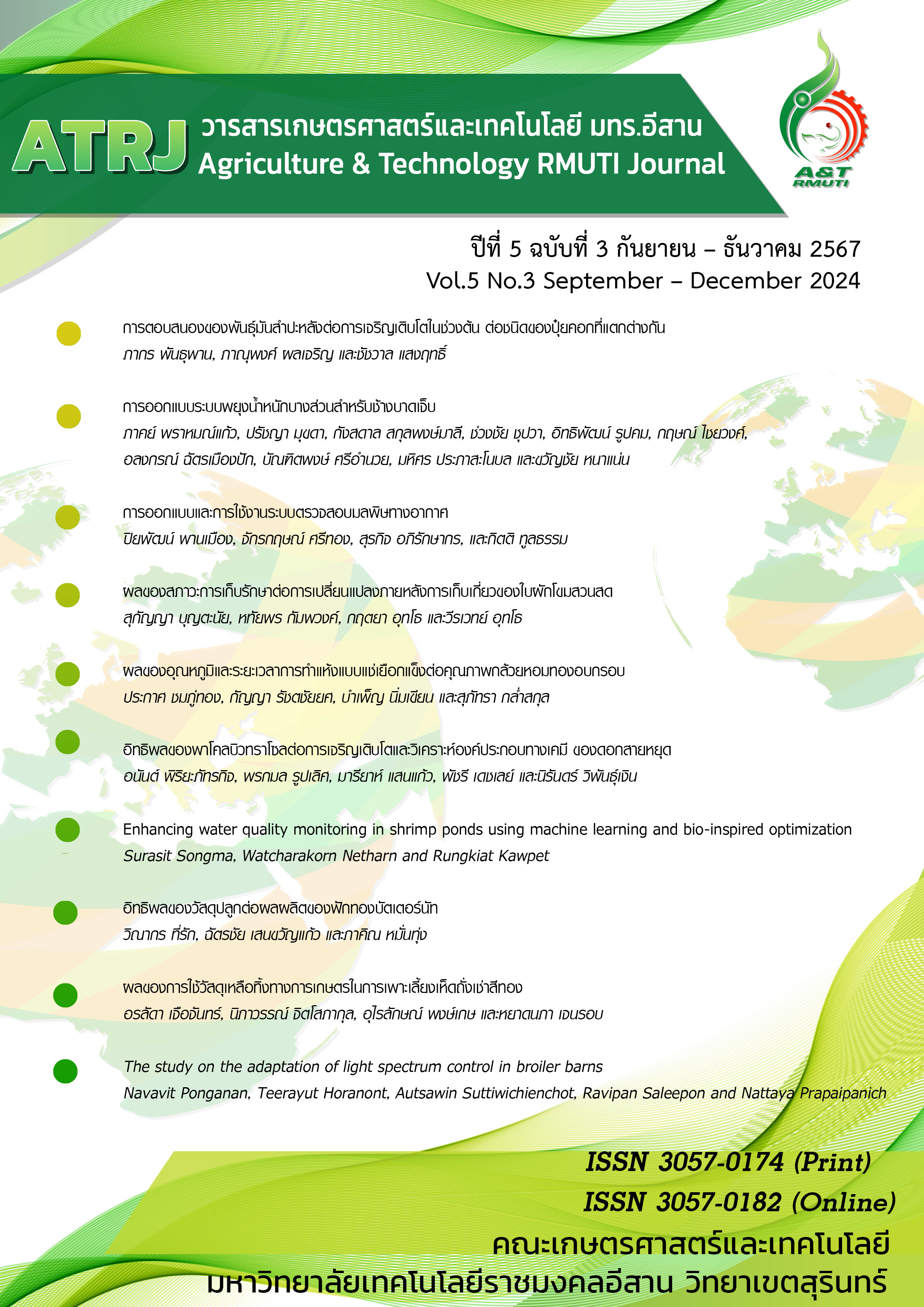อิทธิพลของวัสดุปลูกต่อผลผลิตของฟักทองบัตเตอร์นัท
คำสำคัญ:
สูตรดินปลูก , วัสดุปลูก , การปรุงดิน , ฟักทองบัตเตอร์นัทบทคัดย่อ
การวิจัยนี้มีวัตถุประสงค์เพื่อหาสูตรวัสดุปลูกที่เหมาะสมในการปลูกฟักทองบัตเตอร์นัท วางแผนการทดลองแบบสุ่มสมบูรณ์ (Completely Randomized Design; CRD) ทำการปลูกฟักทองบัตเตอร์นัทในดินและวัสดุปลูกที่พัฒนาขึ้น จำนวน 4 สูตร ได้แก่ สูตรที่ 1 คือหน้าดิน ส่วนสูตรที่ 2 ที่ใช้ขุยมะพร้าว สูตรที่ 3 ที่มีส่วนผสมของขุยมะพร้าว แกลบดำ มูลโคนม อัตราส่วน 1:1:1 และสูตรที่ 4 ที่มีส่วนผสมของมูลโคนม ½ ส่วน หน้าดิน ½ ส่วน ขุยมะพร้าว 2 ส่วน แกลบดำ ½ ส่วน แกลบไก่ ¼ ส่วน ผสมให้เข้ากันปรุงแต่งด้วยรำละเอียด กากถั่วเหลือง จุลินทรีย์สังเคราะห์ด้วยแสง และกากน้ำตาล ทดสอบปลูกกับฟักทองบัตเตอร์นัทสายพันธุ์สควอช จำนวน 4 ซ้ำ ๆ ละ 10 ต้น ในกระถางสีดำเจาะรู ขนาดปากกระถางเส้นผ่านศูนย์กลาง 15 นิ้ว ความสูงกระถาง 10.5 นิ้ว และ ก้นกระถางเส้นผ่านศูนย์กลาง 9.5 นิ้ว จากการทดลองพบว่าวัสดุปลูกสูตรที่ 4 มีคุณสมบัติทางเคมีและธาตุอาหารที่เหมาะสมต่อการปลูกมากที่สุด รองลงมา คือ สูตรที่ 3 และ สูตรที่ 1 ส่วนสูตรที่ 2 ที่ใช้ขุยมะพร้าวเพียงอย่างเดียวมีความเหมาะสมน้อยที่สุด เมื่อนำมาทดลองปลูก พบว่า ฟักทองบัตเตอร์นัทมีการเจริญเติบโตและคุณภาพผลผลิตดีที่สุดที่ปลูกโดยใช้วัสดุปลูกสูตรที่ 4 รองลงมา คือ สูตรที่ 3 สูตรที่ 1 และสูตรที่ 2 ตามลำดับ ดังนั้นแนะนำให้ใช้วัสดุปลูกสูตรที่ 4 ปลูกฟักทองบัตเตอร์นัท
References
นภาพร จิตต์ศรัทธา และพิกุล นุชนวลรัตน์. (2564). ผลของระดับความเข้มข้นสารละลายธาตุอาหารที่ส่งผลต่อการเจริญเติบโตและผลผลิตของฟักทองบัตเตอร์นัทในระบบปลูกพืชโดยไม่ใช้ดิน. วารสารเกษตรพระจอมเกล้า. 39(4): 257-263.
วิภาวรรณ ท้ายเมือง, อรพินท์ สุรกิจ, ธรรมธวัช แสงงาม และ อัญมณี อาวุชานนท์. (2561). ปริมาณธาตุอาหารและคุณภาพผลผลิตฟักทอง 13 สายพันธุ์. วารสารแก่นเกษตร. 46(1): 1348-1353.
Anbu S. and Saranraj P. (2016). Microbially Fermented Soybean Meal as Natural Fertilizer: A Review. Approaches in International Journal of Research Development. 10(1): 1-21.
Armesto J., Rocchetti G., Senizza B., Pateiro M., Barba F.J., Domínguez R., Lucini L. and Lorenzo J.M. (2020). Nutritional characterization of Butternut squash (Cucurbita moschata D.): Effect of variety (Ariel vs. Pluto) and farming type (conventional vs. organic). Food Research International. 132: 109052. DOI:10.1016/j.foodres.2020.109052.
Dermawan R., Kaimuddin, Dungga N.E., Sjahril R., Mollah A. and Yuniarti N.S. (2020). Response of growth and development of butternut squash (Cucurbita moschata) to the combination of bioslurry and NPK fertilization. IOP Conf. Series: Earth and Environmental Science. 575: 012119. DOI 10.1088/1755-1315/575/1/012119.
Dikinya O. and Mufwanzala N. (2010). Chicken manure-enhanced soil fertility and productivity: Effects of application rates. Journal of Soil Science and Environmental Management. 1(3): 46-54.
Eghball B., Wienhold B.J., Gilley J.E. and Eigenberg R.A. (2002). Mineralization of manure nutrients. Journal of Soil and Water Conservation. 57(6): 470-473.
Idi A., Md Nor M.H., Abdul Wahab M.F. and Ibrahim Z. (2014). Photosynthetic bacteria: an eco-friendly and cheap tool for bioremediation. Reviews in Environmental Science and Bio/Technology. 14: 271–285.
Lee S.-K., Lur H.-S. and Liu C.-T. (2021). From lab to farm: elucidating the beneficial roles of photosynthetic bacteria in sustainable agriculture. Microorganisms. 9: 2453.DOI https://doi.org/10.3390/microorganisms9122453.
Nassar K.E.M., EL-Shaboury H.A. and ELSonbaty A.E. (2019). Impact of potassium and manganese on the quantity and quality yields of squash (Cucurbita Pepo L.). Menoufia Journal of Soil Science. 4(2): 57-69.
Nguyen B.T., Trinh N.N., Le C.M.T., Nguyen T.T., Tran T.V., Thai B.V. and Le T.V. (2018). The interactive effects of biochar and cow manure on rice growth and selected properties of salt-affected soil. Archives of Agronomy and Soil Science. 64(12): 1744-1758.
Sugiarto A. and Anggorowati D. (2019). Growth and yield of butternut Squash as a response to the application of organic fertilizer originated from cow rumen liquid on alluvial soil. Jurnal Sains Pertanian Equator. 8(2): 1-10.
Ugrinović M., Girek Z., Pavlović S., Adžić S., Damnjanović J., Gavrilović M. and Ugrenović V. (2021). The influence of organic fertilizers on the seed yield and seed quality of butternut squash (Cucurbita moschata) grown on different types of soil. Book of proceedings of the XII International Scientific Agricultural Symposium “Agrosym 2021”. 753-759.
Uzoma K.C., Inoue M., Andry H., Fujimaki H., Zahoor A. and Nishihara E. (2011). Effect of cow manure biochar on maize productivity under sandy soil condition. Soil Use and Management. 27(2): 205-212.
Vidhanaarachchi L.P. and Somasiri L.L.W. (1997). Use of coir dust on the productivity of coconut on sandy soils. Journal of the Coconut Research Institute of Sri Lanka. 12: 54-71.
Wang D., Shi Q., Wang X, Wei M., Hu J., Liu J. and Yang F. (2010). Influence of cow manure vermicompost on the growth, metabolite contents, and antioxidant activities of Chinese cabbage (Brassica campestris ssp. chinensis). Biology and Fertility of Soils. 46: 689–696.
Wang Y., Wang D., Shi P. and Omasa K. (2014). Estimating rice chlorophyll content and leaf nitrogen concentration with a digital still color camera under natural light. Plant Methods. 10(36): 1-10.
Xiong J., Tian Y., Wang J., Liu W. and Chen Q. (2017). Comparison of coconut coir, rockwool, and peat cultivations for tomato production: nutrient balance, plant growth and fruit quality. Frontier Plant Science. 8: 1-9.
Downloads
เผยแพร่แล้ว
How to Cite
ฉบับ
บท
License
Copyright (c) 2024 วารสารเกษตรศาสตร์และเทคโนโลยี มทร.อีสาน

This work is licensed under a Creative Commons Attribution-NonCommercial-NoDerivatives 4.0 International License.
เนื้อหาและข้อมูลในบทความที่ลงตีพิมพ์ในวารสารทดสอบระบบ ThaiJo2 ถือเป็นข้อคิดเห็นและความรับผิดชอบของผู้เขียนบทความโดยตรงซึ่งกองบรรณาธิการวารสาร ไม่จำเป็นต้องเห็นด้วย หรือร่วมรับผิดชอบใดๆ
บทความ ข้อมูล เนื่อหา รูปภาพ ฯลฯ ที่ได้รับการดีพิมพ์ในวารสารทดสอบระบบ ThaiJo2 ถือเป็นลิขสิทธิ์ของวารสารทดสอบระบบ ThaiJo2 หากบุคคลหรือหน่วยงานใดต้องการนำทั้งหมดหรือส่วนหนึ่งส่วนใดไปเผยแพร่หรือเพื่อกระทำการใดๆ จะต้องได้รับอนุญาตเป็นลายลักอักษรณ์จากวารสารทดสอบระบบ ThaiJo2 ก่อนเท่านั้น






